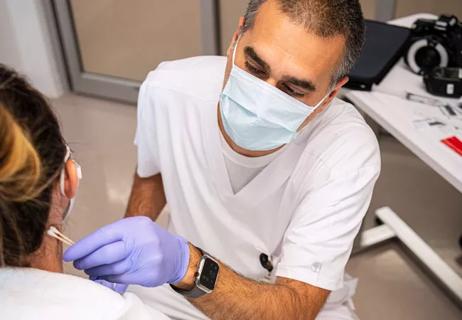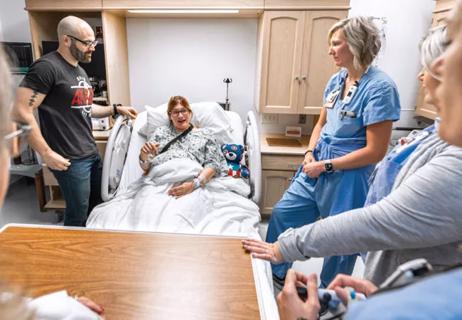Experts emphasize importance of education, preparedness

Healthcare workers are five times more likely to suffer a violent injury at work than those in any other industry, according to the U.S. Bureau of Labor Statistics.1 In an attempt to slow the steady rise of these incidents, The Joint Commission has issued new standards that outline how healthcare organizations can use policy changes, monitoring and education to address the growing problem.2
Cleveland Clinic is a non-profit academic medical center. Advertising on our site helps support our mission. We do not endorse non-Cleveland Clinic products or services. Policy
We sat down with two Cleveland Clinic nursing leaders – Barbara Morgan, MSN, RN, NE-BC, Associate Chief Nursing Officer of Emergency Services and Mary R. Sauer, DNP, MBA, RN, NEA-BC, Chief Nursing Officer at Avon Hospital – to explore how the health system is addressing the national issue of workplace violence.
Q: The Joint Commission standards outline a number of new protocols concerning data collection, workplace analytics and educational and staff responsibilities. How would you characterize the major thrust of these updates?
Morgan: Most importantly, The Joint Commission’s standards are collectively drawing attention to a critical issue that affects virtually every healthcare worker in the country: workplace violence. At Cleveland Clinic, we have intentionally taken a proactive approach to building a culture of safety and emphasizing that violence directed toward our staff, our patients and/or our visitors – in any form – is unacceptable. The new requirements reinforce this important message with four specific standards that apply to caregivers at every level.
Sauer: Nurses have traditionally regarded certain aspects of workplace violence – such as verbal harassment from patients – as an unavoidable part of the job. Fortunately, that is beginning to change. No one should have to work in an environment that makes them feel mentally or physically vulnerable. The new standards not only reiterate that point, they describe effective paths to ensure both the physical and psychological safety of every member of the healthcare team.
Q: The new guidelines entail using data to identify and monitor incidents of workplace violence. Can you share how Cleveland Clinic plans to collect and use this information?
Sauer: When it comes to workplace violence, knowledge really is power. Five years ago, we developed a committee dedicated to tracking and analyzing violent events that occur. We’ve been able to gather and analyze data from across the enterprise, including information collected by the Cleveland Clinic Police, Occupational Safety and Health Administration, and our healthcare system’s own dedicated online Safety Event Reporting System.
Morgan: Each group has its own process for reporting violent events, so we are continuing to work with all parties to better standardize how we collect and document data on workplace violence. Synthesizing the data has been a challenging process, but the information we’ve gathered has been instrumental in informing our priorities and guiding our strategies for identifying and mitigating potential threats.
Q: The new guidelines emphasize the importance of clinical education and training. How is Cleveland Clinic encouraging its caregivers to learn more about the prevention of workplace violence?
Sauer: We emphasize the prevention of workplace violence in every caregiver’s new-hire period. Our new-employee orientation process stresses the importance of personal safety and outlines our organizational policies and procedures for managing and mitigating potentially violent incidents. We also provide periodic educational sessions hosted by leaders from our Nursing, Protective Services, Ombudsman and Caregiver offices.
In addition to having a visible police or security officer present 24/7, our emergency department entry points are all equipped with metal detectors for weapons screening. In addition, our caregivers are taught de-escalation strategies for handling potential threats and are trained to respond to major events, such as active shooter situations. We also highlight our zero-tolerance policy regarding violence by placing “safe workplace” signage in high-visibility areas throughout our hospitals.
Morgan: Our collective goal is to ensure that every caregiver in our enterprise is aligned in their ability to recognize, prevent and react to workplace violence. Our success in providing a safe, nurturing work environment is largely dependent on our ability to execute a uniform response to violent incidents. It’s critical for everyone to be on the same page, and preparedness is critical.
Q: The last standard in The Joint Commission’s guidelines suggests that hospital leaders are chiefly responsible for creating and maintaining a culture of safety and quality. How are Cleveland Clinic leaders rising to this challenge?
Morgan: This is where Cleveland Clinic excels. The prevention of workplace violence is an enterprise-wide priority. From our CEO to every caregiver, ensuring the safety and wellbeing of others is a shared mission. We identified and trained leaders at every level to recognize risk factors for violent behaviors, diffuse them, and support those affected. When faced with a potentially violent scenario, our caregivers know where to turn for guidance and support.
Sauer: We didn’t waste any time in implementing a multidisciplinary approach to workplace violence. By collaborating with experts throughout our health system, we were able to execute definitive strategies and protocols for addressing threatening behavior. Preventing workplace violence is truly a collaborative endeavor at Cleveland Clinic. Thanks to the leadership at every level of our organization, I’m confident that we will continue to meet – and even surpass – the new Joint Commission requirements aimed at reducing incidents of workplace violence in the healthcare setting.
References

Nurses play pivotal role in patients’ ability to recover in the comfort of their own homes

Advocating for patient safety is imperative in fast-paced surgical settings

Advice for those pursuing a WOC nursing career

Redesigned protocols enhance infection-prevention measures

Longevity in healthcare, personal experiences may provide caregivers with false sense of confidence

Specialized team prioritizes trauma-informed care and evidence collection

Collaborative approach leans on expertise of nurses

TeamBirth aims to improve outcomes by facilitating collaboration between patients and caregivers